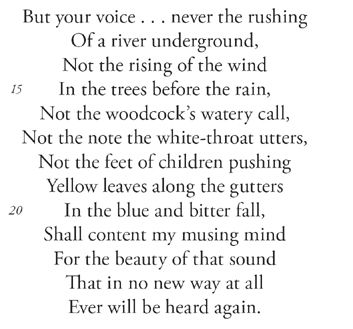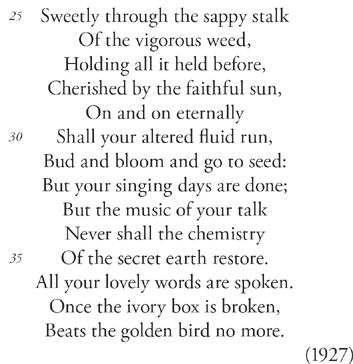| Question | Correct Answer | Your Answer | Result | Explanation |
| 1 | D | 0 | 0 | The sentence, when pared down, is “None of these things shall content my musing mind,” so the correct answer is (D). None of the other answer choices contain the main verb. |
| 2 | C | 0 | 0 | The poem uses the word “blossom” (line 11), but not in comparison to the voice (C), so (C) is the correct answer for this “EXCEPT” question. The voice is compared to the stream (lines 11–12) (A). The voice is compared to the wind (line 14) (B) and woodcock music (line 16) (D). The voice is compared to children’s feet in line 18 (E). |
| 3 | C | 0 | 0 | The author is calling the sun “faithful”—a human characteristic, so this is an example of personification (C). It is not ironic or paradoxical (A), (B). There is no contradiction, so it is not an oxymoron (D). Poetic license is when a writer ignores conventional form or fact to achieve a desired effect. This is not the case here (E). |
| 4 | B | 0 | 0 | The title of the poem is “Elegy,” so we can assume it’s written as an elegy (B). The meter is not regular throughout the poem (A), and the rhyme scheme varies (C). There is no extended allegory (D), and the author is not asking for empathy (E). |
| 5 | A | 0 | 0 | The characters’ similarities are described, followed by their differences (A). The characters are not introduced separately (B). Only the second character is compared to an animal (C). The faces are not described until after their clothes are described (D). There are no inner thoughts (E). |
| 6 | B | 0 | 0 | The tone is one of neutrality—an unbiased narrator describing the action (B). There is no contempt (A). Although they are described, “scrutiny” is too strong a word (C). There is nothing supernatural about the passage (D). There is no inquiry (E). |
| 7 | B | 0 | 0 | The character Ishmael is introducing himself through first-person narration. We don’t really have enough of a story to see if it’s an allegory, and no dialogue or stage direction cues to suggest that it’s drama (A). While the date of the passage is old enough to be historical, again, there’s nothing to suggest that the period the piece is set in is even further in the past (C). The first-person narrative voice suggests that the speaker is addressing someone other than himself (D). Even if one is not well-versed in the politics of the 19th century, the absence of any political references should make it safe to eliminate (E). |
| 8 | E | 0 | 0 | Much of the passage, but particularly the last sentence, suggests a moody man who knows himself well enough to get out to sea when the dark moods strike him. While Ishmael acknowledges that he sails when he has “little to no money in his purse,” it is less for the money than to adjust his moods – we see little evidence of ambition and none of generosity here (A). While “methodically knocking people’s hats off” might be construed as inconsiderate, Ishmael points out that he avoids doing that (B). Since the topic of the entire passage seems to be Ishmael’s potential mood swings and how they send him to sea, one might see him as self-centered, but there’s no evidence of insecure (C). He is sensitive to his own moods, and he does seem to have some sense that his methods work, but (D) is still not as strong an answer as (E)—a good reason to make sure you read all the answer choices before selecting yours. |
| 9 | C | 0 | 0 | For the narrator, sailing is the way he gets rid of his melancholy (“growing grim about the mouth … a damp, drizzly November in my soul”) (C). An old-fashioned meaning of spleen is “melancholy.” Spleen does not mean “path” (A), nor does it refer to the circulation of blood (B). Although a spleen is an organ, the word does not refer to a body part in this context, and it’s not a kidney (D). There is no evidence that the narrator needs to drive off excess energy (E) |
| 10 | E | 0 | 0 | Alliteration (I) can be found in the phrase “growing grim”; hyperbole in “bringing up the rear of every funeral I meet” (beware extreme language) and “it requires a strong moral principle to prevent me …”; parallel structure in the repetition of, “Whenever I find myself …” |
SAT Literature Practice Test 1
Directions: This test consists of selections from literary works and questions on their content, form, and style. After each passage or poem, choose the best answer to each question.
Read the following poem carefully before you choose your answers.
1. The main verb in the second stanza is
A. rising (line 14)
B. pushing (line 18)
C. fall (line 20)
D. shall content (line 21)
E. will be heard (line 24)
2. The “voice” of the deceased is compared to all of the following EXCEPT
A. the sound of an underground stream
B. the wind
C. the blossom of a flower
D. the music of a bird
E. the pattering of feet
3. The phrase “cherished by the faithful sun” (line 28) is an example of
A. irony
B. paradox
C. personification
D. oxymoron
E. poetic license
4. The poem is written in
A. a regular meter
B. the elegiac tradition
C. a consistent rhyme scheme
D. an extended allegory
E. pathetic empathy
Try the following third-person passage and answer the questions that follow.
This passage is from John Steinbeck’s Of Mice and Men.
5. The structure of the passage is best described as
A. two characters are compared and then contrasted
B. each character is introduced and described
C. two characters are compared to each other and then each is compared to an animal
D. two characters’ physical characteristics are described, followed by their clothing
E. characters’ outward appearances are stated, followed by their inner thoughts
6. The tone of the passage can best be described as
A. barely hidden contempt
B. dispassionate description
C. unforgiving scrutiny
D. supernatural invention
E. focused inquiry
Read the following first-person passage and answer the questions that follow.
This passage is from the opening lines of one of the great classics, Moby Dick, by Herman Melville.
7. The passage is best described as
A. allegorical drama
B. character introduction
C. historical commentary
D. interior monologue
E. political satire
8. By the end of the passage, Ishmael emerges as
A. ambitious gut generous
B. crude and inconsiderate
C. insecure and self-centered
D. sensitive but self-confident
E. temperamental but self-aware
9. In line 5, the word “spleen” most nearly means
A. path
B. blood
C. melancholy
D. kidney
E. energy
10. Lines 5-15 (“Whenever I find … as soon as I can.”) contain which of the following?
I. alliteration
II. hyperbole
III. parallel structure
A. none of the above
B. I only
C. II only
D. I & III only
E. All of the above










